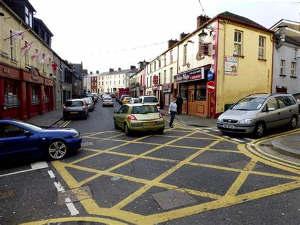Yellow Box Junctions And Road Markings: Highway Code

Yellow box junctions, those criss-crossing yellow lines that pepper busy intersections, are meant to keep traffic flowing smoothly.
However, a recent study commissioned by a member of the motor trade, the RAC, reveals a startling truth: almost every yellow box junction analysed in London and Cardiff is larger than necessary, leading to countless unnecessary fines for drivers.
The RAC enlisted the expertise of Sam Wright, a chartered engineer with a deep understanding of yellow box design and enforcement.
Wright’s analysis of 100 junctions responsible for generating the most fines in 2019 uncovered a staggering reality: 98% were oversized, with the average box exceeding its necessary dimensions by 50%.
This revelation raises serious questions about the purpose and effectiveness of these ubiquitous road markings.
While yellow boxes are crucial in preventing traffic congestion, those that fail to fulfil this function serve no purpose. Furthermore, oversized boxes create additional hazards for drivers, making it challenging to judge entry and exit points. Such ambiguity confounds private and motor trade drivers and increases the likelihood of unintentional infractions.
In light of these findings, the RAC and Wright are urging the UK government to update its guidance to councils regarding the appropriate use of yellow box junctions. Clarity is needed to ensure consistent application across jurisdictions and to prevent unnecessary fines for motorists.
One contributing factor to these oversized yellow boxes is outdated regulation. Many boxes were painted before 2016, when updated specifications were introduced.
Despite more recent guidance emphasising the need for reasonable improvements to highway infrastructure before enforcement actions, inconsistencies persist.
Worryingly, a fifth of the analysed yellow box junctions potentially violate the Traffic Signs Regulations 2016 by extending beyond junctions, being in non-permitted areas, or covering non-compliant sections.
In London, where yellow box junctions are prevalent, fines for misuse can be hefty.
On TfL red routes, penalties reach £160, while London boroughs impose fines of £130. Cardiff and other English authorities enforce fines of £70, reduced to £35 if paid promptly.
Additional motoring costs drivers could do without, such as ULEZ, congestion charges, and increasing insurance policy costs, are other examples, which is why shopping around different insurance brokers is essential.

Understanding road markings is crucial for all road users, whether navigating yellow box junctions or deciphering other traffic regulations.
Here, we will briefly look at common road markings to help clarify their meanings, but we advise you always to do your own research.
Yellow Box Junctions: Filled with crisscrossing yellow lines indicate areas where vehicles must only enter if their exit is clear. They aim to keep traffic flowing at busy junctions.
Stop Line at Signals or Police Control: A white line across the road, often alongside traffic lights or areas of police control, signifies where vehicles must stop if directed by signals or authorities.
White Diagonal Stripes: Used to separate lanes or protect traffic turning right, these markings require caution when entering and must not be entered except in emergencies.
Single and Double Yellow Kerb Lines: Indicate parking and loading restrictions, with double lines always prohibiting loading and single lines indicating restricted loading periods.
Understanding road markings can help drivers navigate roadways safely and avoid unnecessary fines. As we advocate for clearer regulations and markings, let’s strive for safer, more efficient journeys on our roads.







